October 29, 2010
Air Date: October 29, 2010
FULL SHOW
SEGMENTS
Saving the World’s Biodiversity
View the page for this story
An international meeting on biodiversity just wrapped up in Nagoya, Japan. On the agenda: coming up with a treaty to protect the world’s most threatened species and habitats. Host Bruce Gellerman talks with Thomas Lovejoy, senior advisor to the president of the UN Foundation, about the negotiations. (06:00)
Stimulus Money and the Environment
/ Jeff YoungView the page for this story
The economic stimulus act was the country’s biggest-ever investment in renewable energy and efficiency programs. Supporters say it’s paying off in cleaner energy and green jobs. But some programs are marred by wasteful spending and shoddy work. Living on Earth’s Jeff Young has a progress report on the attempt to stimulate a clean energy economy. (05:45)
Keep on Truckin’ for Fuel Efficiency
View the page for this story
The EPA and Department of Transportation are considering new standards to make the latest trucks more fuel-efficient. But some truckers already know how to keep their emissions in check. Host Bruce Gellerman talks with Carl Krites—a super-efficient truck driver from Ohio. (06:30)
Greening Afghanistan
/ Mitra TajView the page for this story
War might have kept the province of Bamiyan hidden for decades, but now Afghanistan's first and only woman governor has established the first national park there and is working to build its future on ecotourism. Living on Earth's Mitra Taj reports on Bamiyan Governor Habiba Sarabi's green ambitions for one of the poorest places in Afghanistan. (05:00)
Harnessing the Power of Soccer
/ Ike SriskandarajahView the page for this story
Four Harvard students invented a soccer ball that charges with every kick. The young inventors hope to harness the power of soccer fanaticism and turn it into clean energy. Living on Earth and Planet Harmony’s Ike Sriskandarajah reports. (06:00)
A Force For Nature
View the page for this story
In 1970, a landmark case to protect an iconic mountain in New York from development led to the founding of one of the most powerful environmental action groups in the country. The Natural Resource Defense Council, headed by founding director John Adams, brought together skilled litigators focused on the creation - and enforcement - of environmental laws. Living on Earth’s Steve Curwood speaks with Adams to learn more about his memoir, A Force for Nature and NRDC’s four decades of fighting for the environment. (10:45)
Cool Fix for a Hot Planet/Tree Wiki
/ Honah LilesView the page for this story
San Franciscans are relying on an open source website to document urban trees rather than use a traditional tree survey. The data logged by community members is used to calculate environmental benefits of the urban forests in the Bay area, and helps city officials better protect them. Honah Liles reports. (01:45)
Field of Screams
View the page for this story
To keep bringing in the green, a family farm in Clayton, North Carolina makes food during the growing season and fear in the fall. Glenn Boyette gives host Bruce Gellerman a tour of Clayton Fear Farm. (06:30)
This week's EarthEar selection
listen /
download
The haunting howl of a lone gray wolf.
Show Credits and Funders
Show Transcript
HOST: Bruce Gellerman
GUESTS: Thomas Lovejoy, Carl Krites, John Adams, Glenn Boyette
REPORTERS: Jeff Young, Mitra Taj, Ike Sriskandarjah
NOTE: Honah Liles
[THEME]
GELLERMAN: From Public Radio International, this is Living on Earth. I’m Bruce Gellerman. To stimulate the economy the Obama administration is turning to green energy, big time.
[SOUNDS OF CONSTRUCTION]
YARALA: What’s happening here is we’re building the world’s largest wind turbine blade and structure testing facility. And without stimulus, my guess is, this would be a parking lot.
GELLERMAN: But paving the green road to recovery can be costly. Critics charge spending stimulus money on clean energy generates waste and fraud. Also, some students kick around bright ideas. Their goal: to shine a light on developing nations.
THAKKAR: There’s this universal love of soccer around the world and then we saw this huge need for electricity and we said, ‘hey, why not, why not put the two together.’
GELLERMAN: And, big trucks may soon need to go on a diesel diet. We get lessons from the national trucking champ on hauling freight the fuel efficient way. Keep your eyes on the road, and your ears tuned to Living on Earth.
[CUTAWAY MUSIC: Boards Of Canada “Zoetrope” from “In A Beautiful Place Out In The Country” (Warp Records 2000).]
Saving the World’s Biodiversity
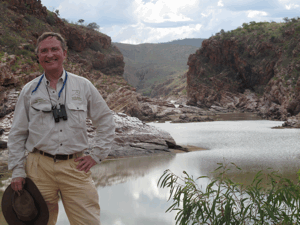
Thomas Lovejoy first coined the term "biodiversity" in 1980. (Heinz Center)
[THEME]
GELLERMAN: From the Jennifer and Ted Stanley Studios in Somerville, Massachusetts, this is Living on Earth. I’m Bruce Gellerman. When it comes to international environmental negotiations there are good cops and bad cops. COP is UN speak for Conference of the Parties-- major summits where delegates gather to hammer out international treaties.
Last December’s COP in Copenhagen is an example of bad COP; negotiators failed to come up with a binding agreement on climate change. For the past two weeks, delegates have been meeting in Nagoya, Japan hoping for a good COP. The Conference of Parties is trying to come up with an agreement to save the world’s biodiversity.
Joining me from the summit to discuss “good cop, bad cop” is Thomas Lovejoy. He’s the Senior Advisor to the president of the UN Foundation. Hi Professor.
LOVEJOY: I’m delighted to be with you.
GELLERMAN: So have the negotiations in Nagoya been good COP or bad COP? Good meeting or bad meeting?
LOVEJOY: So I seem to get different opinions about that. There are those who will feel the targets should have been set higher. There will be those who will be happy that it got as far as it did, all the negotiations who are surrounded by just a fabulous amount of energetic, committed, far looking activity.
GELLERMAN: What are the targets? What are the goals?
LOVEJOY: So the whole set of goals about how a nation can access the benefits of another nation’s biodiversity, think of a potential cancer drug in the middle of, say, the Congo rainforest—you know, what are the rules around that? And the other targets are in many ways the most important ones. The ones that guarantee that those benefits will still be there to be access and shared. And, that revolves around how much of the planet is under some strict form of protection whether on the land or in the oceans.
GELLERMAN: The idea that the benefits are there and that they’re going to be sustainable and sharable presumes that we going to be able to keep biodiversity as diverse as it is.
LOVEJOY: Precisely. And, you know, sometimes, watching the negotiations you wonder whether people will realize that. If you are going to take forever to negotiate the access terms then there are just going to be fewer benefits to be accessed and shared.
GELLERMAN: I heard that we are losing more species today then have ever been lost since the time of the dinosaurs.
LOVEJOY: That’s true and it certainly true in the history of our own species. So, the last time that there was a massive extinction on earth was when the dinosaurs exited. If we keep on the trends that we’re on, we’ll be basically creating the same kind of scenario.

Thomas Lovejoy first coined the term biodiversity in 1980. (Heinz Center)
GELLERMAN: Now, there are people, and I’ve met them, I’ve been to the Amazon for example, the indigenous people who have lived in these biologically rich zones. And they use things that I’d never seen and scientists had never seen, and they have tremendous value.
LOVEJOY: I mean it’s extraordinary what indigenous peoples are able to use from nature. And, you know, we already use some of those things like ‘kirari’ which we use as a muscle relaxant in major abdominal surgery. So the real issue is how do you actually recognize the right to that knowledge that the indigenous people have so that they get some economic return as benefit.
And there’s a lot of worry in the world, particularly in developing countries, that really smart corporate scientists or others are going to swoop in and snatch up the knowledge and make a lot of money. And there will be no return for the indigenous people and that’s call ‘bio-piracy’. The reality is that there are very few real examples of bio-piracy, and in the end, the real bio-piracy is the people who are destroying biodiversity and making it impossible for those benefits to ever be accessed or shared.
GELLERMAN: Well, how do you monetize the value of biodiversity?
LOVEJOY: It’s not so much monetizing as valuing. New York City, a few years back, is a great example of this. The watershed which produced water that was so good that, when I was a kid, that you just noticed when you took a drink of water right out of the tap. That deteriorated the watershed to the point where the EPA was going to require the city to cough up eight billion dollars to build a water treatment plant.
And then somebody got smart and said, ‘you know, I bet you if we restored this watershed and restored the biodiversity, we could do it as a permanent solution for much less cost.’ And that is precisely what happened.
GELLERMAN: So the environment has value that’s not readily apparent except when we really need it.
LOVEJOY: And, well, that’s right. Or when you begin to pull the rug out of it. There’s a wonderful phrase that I heard at the COP, which is ‘humanity does best where nature flourishes.’ You know, we’ve done the experiment that shows what happens when you don’t do that and it’s called Haiti. That’s what happens when you strip the biology out of a country.
GELLERMAN: Now this is the COP ten. You’ve had ten of these going back twenty years and only now are they dealing with this stuff substantially, it seems to me.
LOVEJOY: I think what’s driving it today is a greater sense of urgency than before because people can see a lot of this biodiversity beginning to slip away. That finally makes you focus and spend less time negotiating and more time thinking about how to actually protect the biology of the planet and indeed the human future.
GELLERMAN: Thomas Lovejoy is a professor of environmental science and policy at George Mason University.
Related links:
- Convention on Biological Diversity
- The Heinz Center
[MUSIC: Martin & Wood “Dracula” from Shack Man (Gramavision 1996).]
Stimulus Money and the Environment

(Photo: Bruce Gellerman)

(Photo: Jeff Young)
GELLERMAN: President Obama tried to jumpstart the economy by putting federal stimulus money into alternative energy projects. The funds certainly made solar power’s prospects brighter. Two billion dollars in federal loan guarantees have helped launch the world’s largest solar project in California’s Mojave Desert. It’s just one of thousands of clean energy and efficiency projects boosted by the Recovery Act’s stimulus money.
But critics, backed by a federal investigation, say some of the projects also generate waste and fraud. Living on Earth’s Jeff Young has a progress report on the government’s attempt to stimulate a clean energy economy.
YOUNG: The shadow hanging over solar power has always been cost. It’s too pricey to compete with dirtier sources like coal. A small startup in Lexington, Massachusetts, that cradle of American Revolution, is working on a manufacturing solution. Frank van Mierlo is CEO of 1366 Technologies. He shows me a block of pure silicon and part of the price problem—sawing the silicon wafers that become solar cells.

(Photo: Bruce Gellerman)
VAN MIERLO: You can imagine that if you saw this that you create about as much sawdust as you have left in wafers, and that’s exactly what happens. You waste half the silicon in sawdust. And what’s worse, the cost of sawing is very costly.
[SOUNDS OF LAB MACHINERY]
YOUNG: The 1366 lab is perfecting a process to pull thin wafers directly from molten silicon. Van Mierlo says it could cut the cost of the wafers 80 percent.
VAN MIERLO: That is significant because the wafer is as much as half of the final module cost. And by dramatically reducing that cost we really are making a genuine step toward making solar cheaper than the cost of coal.
YOUNG: The wind industry wants to harness ocean breezes to power east coast cities. But no one’s sure how offshore turbines will stand up in harsh ocean winds.
[SOUNDS OF SAWING AND HAMMERING]
YOUNG: Rahul Yarala says this structure going up in Boston will put those blades to the test.
YARALA: What’s happening here is we’re building the world’s largest wind turbine blade and structure testing facility.
YOUNG: Yarala directs the Massachusetts Wind Technology Testing Center. The 130 foot long structure will vibrate, twist and otherwise punish the biggest turbine blades, making sure they’re seaworthy. Both these companies have one thing in common: the American Recovery and Reinvestment Act of 2009, better known as the stimulus act. The solar start up in Lexington got four million dollars. And Yarala says 25 million stimulus dollars rescued the wind test facility from financial meltdown.
YARALA: And without stimulus, my guess is, this would be a parking lot.
YOUNG: Advocates say the stimulus was the single biggest clean energy investment the country has ever made. Kate Gordon at the democratic-leaning think tank, Center for American Progress, puts it at a little more than 80 billion dollars.
GORDON: That was across a range of things, you know, tax credits and grants for renewable energy development, a big program for energy efficiency for low income houses, some infrastructure projects like smart grid and the transmission lines was fairly comprehensive from a clean energy perspective.
YOUNG: Gordon says it’s too soon to fully assess that investment. But a recent analysis shows results from one stimulus program that put some five billion toward renewable energy.
GORDON: That program was very successful. The American Wind Energy Association anticipates that that program saved about 40,000 jobs in the wind industry that otherwise just would have gone away because projects just would have all died.
YOUNG: That study included indirect jobs associated with the spending. But any way you look at it, Gordon says the impact was big. Stimulus money made possible about 60 percent of all the new wind projects in the country last year. Critics of the stimulus act question whether things like that are worth billions of taxpayer dollars. Leslie Paige is with the fiscally conservative watchdog group, Citizens against Government Waste.
PAIGE: You can always throw 862 billion at a problem and say you created jobs, the question is what kind of jobs were they and at what cost?
YOUNG: Paige says the most waste, ironically, came in an efficiency program—home weatherization. Some weatherization programs saw a thousand percent budget increase. Paige points to a recent report from the energy department’s own inspector general. In Illinois, the IG found shoddy work, poor inspection and over-billing.
PAIGE: The program was, even before the stimulus, vulnerable to waste fraud and abuse. And, we were very, very concerned that by shoving even more money, five billion dollars, into the same program with no oversight that you would run into problems. And the audits that we’re seeing now are actually bearing out that prediction.
YOUNG: Similar issues arose for Texas, Wisconsin and Virginia. The Department of Energy says those problems are being addressed. Cathy Zoi is the DOE’s assistant secretary for efficiency and renewable energy.
ZOI: We are now weatherizing 25,000 homes or so a month. The scale of this effort is huge. It is almost inevitable that some people are going to not do the work the right way in the first place, but we have systems in place to ensure that anything that’s not done well, gets fixed.
YOUNG: Reports on wasteful weatherization projects and wind power jobs quickly entered the election year dispute over the stimulus. But those putting stimulus money to work urge a different perspective.
[SOUNDS OF CONSTRUCTION]
YOUNG: Rahul Yarala invites people to come see the hundreds of construction workers putting up the wind testing lab and consider what it could mean beyond the election cycle.
YARALA: I’m an engineer so I gotta stick to my project. Construction jobs for one year, and it’s leaving behind the world’s best lab. I don’t see where the wastage is.
YOUNG: The stimulus act’s effect on the country’s energy economy will be stimulating debate for years to come.
[SAWING SOUNDS]
YOUNG: For Living on Earth, I’m Jeff Young in Boston.
Related link:
**Web Extra** LOE’s Jeff Young interviews Frank van Mierlo, CEO of 1366 Technologies.
GELLERMAN: Just ahead: a national truck driving champ keeps on truckin’, three million miles and more efficiently. Keep listening to Living on Earth!
[CUTAWAY MUSIC: Jerry Gonzalez & Fort Apache “Misterioso” from Rhumba Para Monk (Sunnyside Records 1989).]
Keep on Truckin’ for Fuel Efficiency
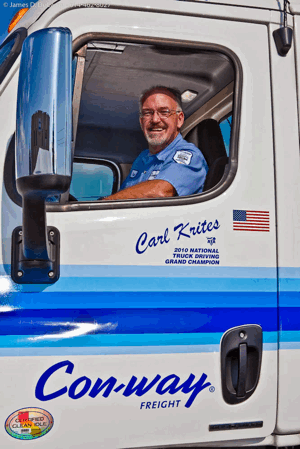
Carl Krites is a trucker with Con-Way Freight in Ohio. (Photo: James DeCamp and Con-Way Freight)
GELLERMAN: It’s Living on Earth, I’m Bruce Gellerman. Within a few years, medium and heavy-duty trucks in the United States could be rolling down highways and byways using a lot less fuel, and emitting a lot less greenhouse gases. The EPA and Department of Transportation have proposed new standards set to go into effect in three years. If the new regs are adopted, the agencies estimate the new fleet of fuel efficient trucks will provide more than 40 billion dollars in benefits over the lifetime of the vehicles.
However, to get those savings will take a hefty dose of high tech: expensive new engine designs, drive trains and streamlined aerodynamics. But according to a recent study by the National Research Council there’s a lot truckers can do right now to cut fuel consumption and curb tailpipe emissions at little or no cost. When it comes to driving efficiently Carl Krites is what you might call the MVP of MPGs. He’s a trucker with Con-way Freight in Ohio and this year’s National Truck Driving Champion. Mr. Krites, congratulations. Welcome to Living on Earth.
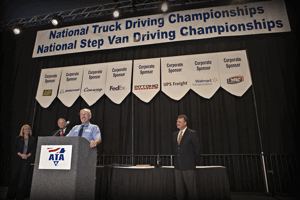
Carl Krites accepts his award for this year’s National Truck Driving Champion. (Photo: James DeCamp and Con-Way Freight)
KRITES: It’s quite a pleasure.
GELLERMAN: You’ve been driving for what, 31 years?
KRITES: 32 as of the first of September.
GELLERMAN: Huh. I guess over the years you’ve put on a few miles in your time.
KRITES: Right at three million miles without a chargeable accident.
GELLERMAN: Phew, that’s a good record. What kind of truck do you drive?
KRITES: Right now I work for Con-way Freight and we pull doubles, we haul LTL freight.
GELLERMAN: 18-wheeler, I guess?
KRITES: Yes, sir.
GELLERMAN: So do you have special techniques that you use to save gas?
KRITES: My biggest thing is, and especially with Conway Frieght, we’re real conscious about fuel economy and stuff. Our trucks are all governed at 62 miles an hour. And, you know, they put out the numbers as to how much fuel we save going from 62 instead of 65, and that itself is astronomical money savings in our fleet. And not only that, but, just the fuel savings.
GELLERMAN: Yeah. I was reading that you go from 70 miles to 65, you save eight percent right off the top.
KRITES: Exactly. I get called a dogger because I shut my cruise at 60. To me two-miles an hour isn’t going to make that much difference, but you actually save a little more fuel.
GELLERMAN: A dogger? Is that what they call you?
KRITES: They call me ‘dog-ing it’.
GELLERMAN: (Laughs). So if you have an 18-wheel, you’ve got a lot of tires there… I know you’re supposed to keep your tires inflated. Do you keep your tires inflated?
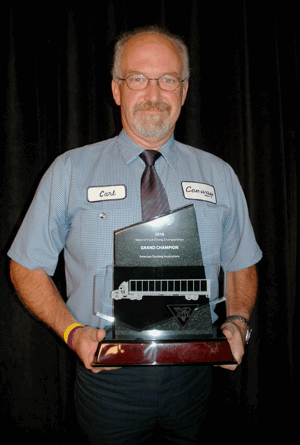
Carl Krites is awarded a trophy for having an impeccable safety record and for driving efficiently. (Photo: James DeCamp and Con-Way Freight)
KRITES: Yeah, we do a pre-trip inspection and then our units RPM maintenance regularly and I do a thump test every morning, you know, just to make sure I don’t have a low tire or something because that does make a big difference. You know, I had a guy explain to me the amount of fuel savings you can get just from keeping your tires inflated right. People just don’t realize it.
GELLERMAN: What about shifts? How many gears do you have?
KRITES: I got a ten-speed.
GELLERMAN: A ten-speed. How do you make sure you’re in the exact right gear? Because I was reading that if you shift one gear down you can increase your fuel consumption by 15 percent.
KRITES: Right. You know RPM range for mine is like around 1250 and I usually run right at around 1100 RPM’s and stuff, just a little below max. I like to have something in reserve in case you need a little extra throttle to get out of a situation or something like that, you don’t want to be max-ed out.
GELLERMAN: Do you do double clutching with ten gears? I would guess you would have to at some times.
KRITES: (Laughs). Uh, to be totally honest, I use a clutch when I stop and start and otherwise I just use synchronized shifting.
GELLERMAN: You’re kidding. You just push it in.
KRITES: Never touch the clutch once I pull away from a stop sign or stop light.
GELLERMAN: And, does that save you gas?
KRITES: Yes. It saves you foot power, it saves you wear and tear on the clutch and the modern transmissions are so synchronized that if you use your RPM range like it’s recommended, it’s synchronized so well that it just falls right out and right into the next gear.
GELLERMAN: What about pit-stops? I was reading that if you consolidate your stops for food and fuel and so on, you can really save quite a bit of gas. I guess a third of a gallon of gas is used by truckers just to return to a highway speed.

Carl Krites is a trucker with Con-Way Freight in Ohio. (Photo: James DeCamp and Con-Way Freight)
KRITES: Right. And also, you know what a lot of guys don’t realize, if you idle your truck for one hour, you burn a gallon of fuel.
GELLERMAN: I understand why Con-way would do it. They’re saving a lot of money on gas, on fuel.
KRITES: Absolutely. We run 4,400 line-haul, on what we call line-haul runs every night, across the United States and Canada. And, if you can save two percent of fuel on each unit at 4,400 units running up and down the highway at night, you’re saving a lot of money and you’re saving a lot of fuel.
GELLERMAN: Are there other drivers who are as conscientious as you at Con-way in terms of fuel efficiency?
KRITES: Uh, yeah. Actually there are. There are some of the old-school guys that, you know, haven’t really caught onto it yet. But there are several of us that, you know, you look at it and the thing with us is that— and maybe this is a little self-centered— we do a profit sharing at the end of the year, so anything we can do to help save money for our company, you know, there’s a big bonus for us.
And not only that but it’s just the wear and tear on the vehicle’s less if you’re conscious, cause if you’re trying to be fuel efficient and save fuel, you’re driving in a better manner all the way around. And the biggest thing to me is we reduce our reliance on foreign oil and, you know, the safety factor, you know, and the reputation of the drivers overall. Through a period of time where the reputation of a truck driver wasn’t real good, but now the positive light- I know the numbers are out and over 80 percent of the amount of the American public has a positive attitude toward truck drivers because they’ve realized it’s not just a job anymore, it’s a profession.
And, we take pride in what we do. And, you know it’s not different from a doctor going to work and taking pride in what he does, you know. We all try to do that.
GELLERMAN: So how long do you plan to drive?
KRITES: (Laughs). My goal, my goal is 58, and that’s eight years from now. I just turned 50 this year. I’d like to get to four million miles.
GELLERMAN: Do truckers still use CB radios?
KRITES: Oh yeah, yup.
GELLERMAN: So what’s your handle?
KRITES: (Laughs). Uh, my handle is Skeeter.
GELLERMAN: Skeeter?
KRITES: Yes sir. And I’ve had that since I was very small. My grandfather always told me that I buzzed around like a blank skeeter and the name just stuck. I guess I could never sit still.
GELLERMAN: (Laughs). Well, Skeeter, ten-four.
KRITES: Well thank you Bruce, it’s been a pleasure and quite an honor.
GELLERMAN: Carl Skeeter Krites is the 2010 National Truck Driving Grand Champion. He drives with Con-way in Ohio. How do you save fuel? Let us know and if we pick your idea and put it on the air, we’ll send you a shiny blue Living on Earth tire gauge. Email us at comments at L-O-E dot org. That’s comments at L-O-E dot O-R-G. Or post your idea on our Facebook page. It’s PRI’s Living on Earth.
[MUSIC: Club D’Elf “Hungry Ghosts” from Perhapsody Live 10-12-06 (Kufala Records 2007).]
Greening Afghanistan
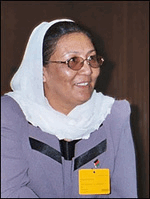
Bamian Governor Habiba Sarabi wants her province to host ecotourists from all over the world. (Photo: USAID)
GELLERMAN: National parks are peaceful places where people go to reflect on the beauty and wonderment of nature. The United States is blessed with 58 national parks, but Afghanistan, which sure can use the peace and tranquility, has only one. It was founded in a war zone on Earth Day 2009. Living on Earth’s Mitra Taj reports on the Band-e-Amir National Park and the woman who helped establish it.
TAJ: People who have traveled to Band-e-Amir describe their visits as “surreal.” A bumpy drive into the heart of a torn country, past abandoned tanks and valleys of un-cleared land mines. And in the middle of the desert, tucked into jagged mountains—a sudden blue beauty.
Six lakes, as bright as the sky above, spill water over twisting limestone formations. Band-e-Amir, in the province of Bamiyan, is Afghanistan’s first and only national park, and represents the vision of the country’s first and only woman governor: Habiba Sarabi.
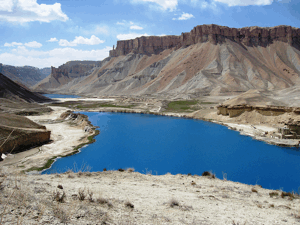
Band-e-Amir National Park. (Photo: USAID)
SARABI: We have very beautiful lakes in Bamiyan, crystal blue lakes, supposed to be announced as a national park during the ‘60s, but unfortunately due to war and conflict in Afghanistan we were not able to do it.
TJA: Not until last year, when the park was finally announced. Sarabi is short and unassuming. She wears a light-colored headscarf and a gentle smile. She’s a hematologist, and during the Taliban years she lived with her children in Pakistan, secretly teaching Afghan girls.
While she was away, the Taliban destroyed Bamiyan’s famous stone Buddha statues, and the huge gaping holes where they once stood, now watch the road to Band-e-Amir National Park. Sarabi supports rebuilding the icons, and her efforts to revive the province recently earned her an invitation to Washington, DC to meet with other women conservationists.
AYLWARD: Governor Sarabi is an inspiration to everyone.
TAJ: Kelly Aylward works for the Wildlife Conservation Society and spent a week with Sarabi while she was here.
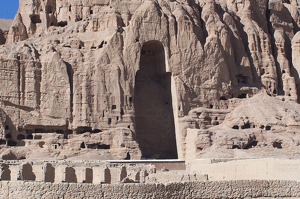
Where one of the stone buddhas once stood; the shadow of war still lingers over Bamian. (Photo: Carlos Ugarte)
AYLWARD: I think she saw the national park as a natural benefit for the people in her province and the potential for the long-term for the entire country. When I met her I was taken by her strong conviction and her fairly small voice.
TAJ: Governor Sarabi uses her small voice to sing the praises of the province she governs, and to try to turn its treasures into a foundation for growth.
SARABI: We should think about the sustainable economic development. So our vision is to promote ecotourism in this province, but ecotourism cannot be promoted without conservation. Ecotourism means that to respect the culture, to respect the nature, to respect the heritage and with that we have to bring responsible tourism in Bamiyan.
TAJ: Surprisingly, Sarabi’s province is safe for tourism: relatively calm and peaceful. Sarabi complains that other provinces, battlegrounds for Taliban and NATO control, attract most of the attention, and most of the development funds. So as the current war rages toward its 10th year, Sarabi is quietly working to build a future of one of the most underdeveloped places in the country.
FOLADI: Bamiyan is poor.
TAJ: Amir Foladi runs the Bamiyan Ecotourism Programme.
FOLADI: More than 85 percent of the income is through agriculture, but because of the harsh winter they cannot harvest two times a year, just once a year.
TAJ: Foladi says the same rugged environment that allows farmers to reap just one harvest a year can support tourism year round.
FOLADI: Bamiyan has a very rich cultural and natural heritage, like the Buddha niches, the caves with mural paintings, and the Ajar valley—the hunting place for the last king—Koh-i-Baba mountains, with lakes at the top of the mountains, and there is trekking for the summer, and skiing in the winter, and the local culture and traditions is also very attractive for tourists.

Bamian Governor Habiba Sarabi wants her province to host ecotourists from all over the world. (Photo: USAID)
TAJ: Foladi and his colleagues have already trained 20 tour guides to work at Band-e-Amir, and hope to hire many more. They’re also helping locals set up guest homes, and writing a guidebook for the area. Already one project—the Silk Road Festival in the summer—has turned into a success, drawing 7,000 tourists last year, a thousand more than the year before. Most were Afghans, and figuring out how to bring foreign tourists through the chaos of the rest of the country and into Bamiyan is still a challenge.
FOLADI: I hope in two to three years we will have better security in the country and good access to Bamiyan so we will have many tourists.
TAJ: But ecotourism isn’t the only potential answer to Bamiyan’s poverty. In June of this year the U.S. Geological Survey released a stunning report: Bamiyan is sitting on a trillion dollars worth of iron ore. Afghanistan’s Mining Minister is now considering bids from mining companies. Governor Sarabi welcomes all economic development, but prays it will be done carefully.
SARABI: This mine shouldn’t destroy the environment. The only concern for us is the environment.
TAJ: For Living on Earth, I’m Mitra Taj in Washington.
Related links:
- The Wildlife Conservation Society's environmental work in Afghanistan.
- Click here for more on tourism in Bamian.
- Governor Sarabi met with other women conservationists with the Alliance for Global Conservation.
[MUSIC: Charlie Haden “Haunted Heart” from Haunted Heart (Verve Records 1991).]
Harnessing the Power of Soccer

An early sOccket prototype undergoes a battery of tests in KwaZulu Natal, South Africa. (Photo WhizzKids United)
GELLERMAN: A group of Harvard students is harnessing the power of the world’s most popular sport. They’ve built a soccer ball that charges with every kick, and post game can power a light. Popular Mechanics calls the ball one of the breakthrough innovations of the year. The creators call it the ‘sOccket.’ Living on Earth and Planet Harmony’s Ike Sriskandarjah has our story.
SRISKANDARAJAH: A group of four Harvard students is trying to tackle the problem of being off-the-grid with a solution on the field. Hemali Thakkar, a graduating senior, is one of the co-creators of sOccket.
THAKKAR: This is sOccket, it’s a soccer ball with the ability to generate electricity.
SRISKANDARAJAH: Thakkar holds up what, on the outside, looks like a regular white soccer ball, but inside…
THAKKAR: Every time you kick the ball there’s a magnet that goes back and forth through the inductive coil which allows a current to be captured in a capacitor and electricity can be stored and used later on.
SRISKANDARAJAH: Similar to a shake to charge flashlight…
THAKKAR: Shake to charge flashlight-- it’s the one where you shake it and the more you shake it, the more light you have.
[MUSIC: Outkast “Hey Ya” from The Love Below (LaFace 2003): “shake it, shake it, s-shake it, shake it like a Polaroid picture…”]
[KICKING A SOCCER BALL]
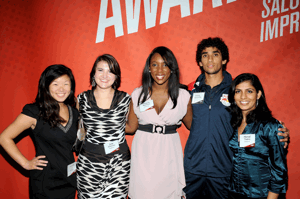
Popular Mechanics honored the sOccketeers as one of the Breakthrough Inventions of the year. From left to right: Jessica Lin, Jessica Matthews, Julia Silverman, New York Red Bulls player Medhi Ballouchy and Hemali Thakkar. (Photo: Popular Mechanics)
THAKKAR: So right now you need about 15 minutes of kicking the ball that allows us to use a single LED. It will be lit for three hours. So let me take you over to where the lamp is. So right now how you would use it, you would plug the lamp directly into the input that’s on the ball.
Voila! You can see the light.
SRISKANDARAJAH: A glowing reading light connects to a wire that ends in a DC plug, sticking out of the ball.
THAKKAR: You know when its pitch dark, its amazing how, like, a single LED can make such a big difference.
SRISKANDARAJAH: Making a difference was the goal of Thakkar and her three co-creators. The four of them, all women, non-engineers, had a class assignment to design a project that tackled a global social problem.
THAKKAR: And we saw that there was this universal love of soccer around the world and we saw this huge need for electricity and we said, ‘hey, why not, why not put the two together.’ And that’s how sOccket came about.
SRISKANDARAJAH: Soccer is often played in poor places and the UN Development Program estimates that nearly 80 percent of the Third World- the 50 poorest nations- has no access to electricity. And in those places people rely on unsustainable, unhealthy energy sources.
THAKKAR: And, what the problem is right now in developing countries is that a lot of people use kerosene. Kerosene lamps cause these fumes that are really bad every time you inhale them, so it causes respiratory illnesses. And those are supposed to be one of the biggest causes of morbidity and mortality in developing countries.
SRISKANDARAJAH: Over one and a half billion people worldwide use kerosene to light their homes. Respiratory infections account for the largest percentage of childhood deaths in developing nations. The environmental impact of kerosene is severe as well. The yearly carbon dioxide emissions from all those lamps around the world equals the emissions from about 38 million cars.

An early sOccket prototype undergoes a battery of tests in KwaZulu Natal, South Africa. (Photo WhizzKids United)
The Harvard team passed their ball off to a design firm to give shape to their idea. And this past summer, the sOccket team took their prototype to test it where the need for clean electricity and love of soccer was the highest.
[MUSIC: THEME SONG FROM THE SOUTH AFRICAN WORLD CUP: “Wavin’ Flay” by K’naan (A &M 2009)]
THAKKAR: We were able to take ten to 20 sOcckets to World Cup and it was in South Africa, which was the best place to be able to test sOcckets.
[MUSIC: THEME SONG FROM THE SOUTH AFRICAN WORLD CUP: “Wavin’ Flay” by K’naan (A &M 2009)]
SRISKANDARAJAH: The home of the 2010 world cup gave the sOccket inventors a great opportunity to see how their ball fared on some well-tread, no frills, South African fields.
The young women worked with Marcus McGilvray, founder of the South African based WhizzKids United. He runs a HIV care and prevention organization that uses soccer to reach at-risk kids. McGilvray had first met one of the Harvard inventors a year earlier and introduced her to his crack team of product testers.
MCGILVRAY: These children often, you know, they make footballs out of carrier bags and rolled up newspaper so they are always very excited when they have the opportunity to play with a football and then, of course, this football generated a lot of interest.
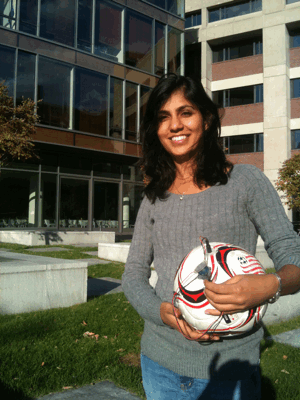
Hemali Thakkar holds up the latest, sOccket 2.0, at Harvard University. (Photo: Ike Sriskandarajah)
SRISKANDARAJAH: I asked him how the ball held up against his soccer-crazed kids.
MCGILVRAY: The ball stood up to the conditions and it held out really well.
SRISKANDARAJAH: But McGilvray also says there’s room for improvement.
MCGILVRAY: Certainly we could see that they were charging. What the sOccket team realized was though, from the trials, was that they were going to have to go back and actually work on the connection inside.
SRISKANDARAJAH: So the Harvard sOccketeers took these suggestions back and are hoping to have a new version of the ball on shelves next summer. Proceeds from American sales would support a buy one- give one model, so groups like Whizzkids in South Africa could start including the balls into their own programs teaching soccer and life skills.
MCGILVRAY: sOccket really gives it a whole new dimension to be able to show them what innovative inventions are coming up around the world. You know, it gets young people to think, ‘Wow!, You know, I think these are great things for children to learn from.’
American Express philanthropic, Members Project, created an ad for the sOccket.
SRISKANDARAJAH: A ball that powers an LED won’t end poverty or fix the environment. But it may inspire kids to think about other simple solutions to big problems and help people breathe a little easier. For Living on Earth and Planet Harmony, I’m Ike Sriskandarajah
Related links:
- sOccket's website
- Learn more about HIV intervention through soccer at Whizz Kids' website
GELLERMAN: For more on the electrifying soccer ball, visit My Planet Harmony dot com. Our sister program, Planet Harmony, welcomes all and pays special attention to stories affecting communities of color. Log on and join the discussion at My Planet Harmony dot com.
[MUSIC: Jake Shimabukuro “Thriller” from Live (Hitchhike Records 2009).]
GELLERMAN: Coming up: recalling some of the major battles of the environmental movement fought by the Natural Resources Defense Council. That’s just ahead on Living on Earth.
[CUTAWAY MUSIC: Manu Katche: “Number One” from Neighborhood (ECM Records 2005).]
A Force For Nature
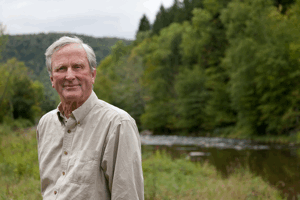
John Adams (Photo: Anthony Clark/NRDC)
GELLERMAN: It’s Living on Earth, I’m Bruce Gellerman. The 1960s and early ‘70s were a time of great social upheaval and environmental activism. It’s when John Adams help found the Natural Resources Defense Council.
ADAMS: Well, the mood was in the air for change. People were worried about the war and they were working on civil rights issues and the environment seemed to be a burgeoning issue led by books by Rachel Carson, the burning of the Cuyahoga River, the oil spill out in Santa Barbara, and the Storm King case.
GELLERMAN: Storm King Mountain, with its iconic view of the Hudson River, was
threatened by plans to build a power plant. In a landmark court case, a conservation group was permitted to sue on behalf of the public interest and Storm King Mountain was protected. That success was one of the first for what has become one of the nation’s most powerful environmental action groups.
The NRDC or Natural Resources Defense Council was founded in 1970. NRDC's first Executive Director was a young lawyer named John Adams. Over the span of the next four decades, the NRDC has been at the forefront of many of the most important environmental battles, which Adams chronicles in his new book, “A Force for Nature.” LOE’s Steve Curwood got John Adams to tell some of those stories:
CURWOOD: Now, what did you initially hope to accomplish with NRDC?
ADAMS: Well, the first thing we wanted to do was to help establish the laws that were needed to help protect the environment. Laws like the Clean Air Act, the Clean Water Act, Toxic Substances Control Act. Remember that in 1969, there were no environmental laws. The laws were written in 1970 and that next, and the decade and the years that followed. And we wanted to be there for the writing of those laws so that they were strong, and then to work on the regulations that followed so that they could be enforceable and we could really accomplish something with them.
CURWOOD: Lets get your history right here. I mean, you were a cop before you started working for the creation of the NRDC. I mean by a cop you were a prosecutor enforcing the law.
ADAMS: That’s right. I was, for almost five years, in an assistant US Attorney working for Robert Morgenthau. I would say I was getting an education. We were trained how to litigate, how to make decisions, how to work on public policy issues, and really learn how to get a strong backbone at a young age.
CURWOOD: And, so, the way you tell the story it sounds like the NRDC was set up to be the cop of the EPA.
ADAMS: Well there’s no doubt that we were set up to protect the citizens- citizens who cared about the environment. My belief is that NRDC strength is that we represent people out across this country who care about the environment and we will bring actions on their behalf to make sure that that environment that they care about is protected.
CURWOOD: Now one of the first cases that you take on in a big way is that you sue the nations’ largest electric utility, the Tennessee Valley Authority- a federal authority. What was that case about and what did you accomplish?
ADAMS: The case was about strip mining. And, we were after a big quasi-governmental company because they were a huge user of coal. And, we wanted to force them to clean up their act and stop the strip mining of eastern Kentucky and into West Virginia, and Tennessee and we won an initial victory. But, ultimately, we lost. What we learned from that battle is that coal is a very difficult customer. And we have been engaged in the coal issues, for, really, three decades, most recently on mountaintop removal.
CURWOOD: John Adams, back in 1989, you and the NRDC released a report on pesticides and other agricultural chemicals called ‘Intolerable Risk.’ And, you initially focused on the chemical used on apples known as alar. Can you tell me that story please?
ADAMS: There were several of our NRDC people who were married with little children, and one was Robin Wyatt. She was worried about what her little children were eating. She was studying the amount of food and the amount of pesticides that gets into food and particularly she focused on alar because her children were drinking a lot of apple juice, and alar, a known carcinogen, was on a lot of apples. And, the standard for measuring apples and the carcinogen was based on a 160 lb man, and her child was some 28 pounds.

John Adams (Photo: Anthony Clark/NRDC)
And, so, they did a market-basket study of food that came into households. The apples, particularly, came up with very high levels that exceeded the legal limit. So, we went public and we issued a report. 60 minutes did a program and ultimately, a real big bang happened out there. There was a lot of charges and counter charges that we were trying to scare people. And, they really went after us. But, you know, ultimately Uni-Royal withdrew alar from the market. And a lawsuit that had been brought by the apple growers against NRDC was dismissed. The alar case led to, really, the beginning of the great new food movement in this country of food free of chemicals and pesticides.
CURWOOD: I think one of the most interesting stories about the NRDC that I found in your book is the story you tell about NRDC’s role in verifying the test ban treaty with the United States and the Soviet Union, the former Soviet Union. And, you ended up working with the KGB…
ADAMS: It’s a great story. And, it’s the story of a great person, Tom Cochran, who’s a physicist with NRDC. And, he was approached by people from the Soviet Union at a meeting presumably KGB, and he was told that the Soviet Academy of Science, run by a man named Velakov, was interested in seeing whether or not there could be something done on a test-ban treaty, particularly with verification using seismometers.
CURWOOD: And, I don’t imagine the KGB actually told you that they were in this operation?
ADAMS: No, but we knew they were. We were traveling with Henry Brick, a banker here in New York who came on the trip and he was a former CIA employee, and he set up a couple of his own traps around his briefcase and found that they were being disturbed. When Tom called me about this opportunity, I said, “Tom, this is really very important. Every time you’re contacted by anybody make a file record and send a copy of it to the FBI.”
CURWOOD: Did the FBI follow you around when you were dealing with these KGB guys?
ADAMS: Well, that’s interesting. I don’t know. But I do know the KGB followed us everywhere.
CURWOOD: (Laughs).
ADAMS: You know then we became friends with several of the people and they told us that they could not have done the work that they were doing if they were not a part of the apparatus.
CURWOOD: Why was it so important that NRDC provide this material to verify the presence of nuclear explosions?
ADAMS: The United States didn’t trust the Soviet Union. And that was it, pure and simple. The president didn’t trust them. And so, a trip was arranged to Moscow, and Tom presented his plan about bringing over to the Soviet Union seismometers and the scientists worked in this area to set up a system to test whether or not an underground test could be verified by the use of seismometers.
Theoretically you could tell the difference between an explosion with dynamite or a nuclear explosion or an earthquake or even an industrial explosion. And we had signed an agreement with Velokov and the Soviet Academy and off we went and they drilled holes in the mountain in Tajikistan and several other places to set up these seismometers. They set off the explosion, and that test and the continued use of seismometers in the Soviet Union helped to bring President Regan and the administration into an agreement with them on the verification.
CURWOOD: So, with this equipment in place provided by the NRDC, the United States and the Soviet Union were able to execute a test-ban treaty?
ADAMS: It became the basis for it, yes.
CURWOOD: So, why didn’t you guys get the Nobel Peace Prize?
ADAMS: You know, I’ve often wondered why Tom Cochran didn’t get a major prize for this work. But, you know, we were a small organization and we were only growing into our size, and maybe if it had happened this year we would have. But, maybe someday he’ll be recognized for it the way he deserves.
CURWOOD: So, John Adams, 40 years after you gave up that nice, secure job at the US Attorney’s office to go with the fledgling Natural Resources Defense Council, what would you say is the most important thing you’ve learned?
ADAMS: Well, the most important thing is to have a great wife who’s the co-author of this book. As for my view of what is absolutely the single most important thing is- we have created an organization that allows the public to participate in decision-making. And, we challenge the government, we challenge the companies, and we represent the environmental positions on the environment and on health, and we think that’s a very, very important role that could well have been over-looked.
CURWOOD: John Adams is the co-author of “A Force for Nature: The Story of NRDC and the Fight to Save our Planet.” Thank you so much, sir.
ADAMS: Thank you very much for doing this.
GELLERMAN: John Adams, founding director of the NRDC, spoke with Living on Earth’s Steve Curwood.
Related links:
- Natural Resources Defense Council
- Click here to hear an extended interview with John Adams
[MUSIC: Erik Truffaz “The Mask” from The Mask (Blue Note Records 2000).]
GELLERMAN: In just a minute: A farmer gives his hoe the heave hoe and raises an ax to scare up some Halloween profits. But first this Cool Fix for a Hot Planet from Honah Liles.
Cool Fix for a Hot Planet/Tree Wiki
LILES: These days, it seems like wikis, the open source collaborative websites, are sprouting up everywhere. There’s a wiki for quotes, a wiki for travel, a wiki for star wars. And now, there’s a wiki for trees.
[COOL FIX THEME]
The Urban Forest Map wiki relies on community members to document every single tree in the San Francisco area. A tree survey typically costs about three dollars a tree, and in a city with hundreds of thousands of trees, that adds up quickly. But with the Urban Forest Map, community volunteers record and update data, which cuts costs and leads to accurate and current information. On the site, every tree has a profile page listing information including location, species and size. Based on those specifics, the amount of carbon dioxide and air pollutants removed from the air by each tree is also listed.
This treasure trove of data helps city officials and community organizers manage and protect urban tree populations, and allows scientists to study the relationship between urban forests and climate. Supporters of the project are hoping that this new type of wiki will put down roots in other cities across the country. That’s this week’s cool fix for a hot planet. I’m Honah Liles.
Related links:
- Urban Forest Map
- San Francisco’s Urban Forest Map
- Urban Forest Map’s Facebook Page
Field of Screams

During the Halloween season, on fear farms like the Boyette's, pumpkins turn to haunted jack-o-lanterns when night falls.
GELLERMAN: What’s happening to the nation’s family farms is frightening. While they make up 98 percent of the U.S. farms, they’re responsible for just 15 percent of production. And here’s the really scary part: nearly half of the families down on the farm don’t turn a profit. So a growing number are resurrecting their plots and turning them into….
[MUSIC: Various Artists “Toccata and Fugue in d Minor for Organ BWV 565” from The 50 Most Essential Baroque Masterpieces (X5 Music Group 2010)]
GELLERMAN: Haunted attractions…
[MUSIC]
GELLERMAN: Come the harvest moon thousands of family farmers in the United States become pumpkin sellers, maize makers and purveyors of fear as they try to scare up money from fallow fields. Glenn Boyette’s farm in Clayton North Carolina has been in the family for generations, this time of year he turns it into the Clayton Fear Farm.
BOYETTE: It was my grandfather’s, and you know, he passed it down to one of my uncles and then my wife and I purchased his estate. We’re in the produce business. This year we concentrated on sweet corn and watermelons. Labor was getting extremely hard to come by, and we were looking for an alternative method of getting some revenue on the farm. And I attended a haunted house convention that was in Charlotte, North Carolina—Haunt-Con.
GELLERMAN: A haunted house convention? Did you meet a lot of people who in their past lives were family farmers?
BOYETTE: A bunch. I knew absolutely nothing about the haunted house industry. And after that, we visited several of the farms all over the country, picked up ideas and brought them back here and turned it into our theme. It’s called Clayton Fear Farm, and it’s a Halloween haunted house or Halloween haunted theme park, and we just grew from there.
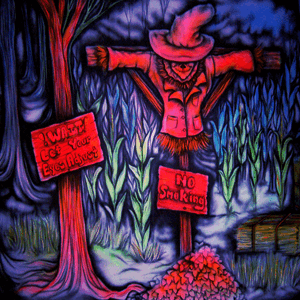
The Boyette's fear farm includes a haunted house that requires 3D glasses to truly appreciate. (Photo: Clayton Fear Farm)
GELLERMAN: How long has fear been running in the Clayton family farm?
BOYETTE: This is our ninth season.
[SOUNDS OF BULL SCREAMING]
BOYETTE: That was the bull that was going crazy, that was about to meet his- meet his fate.
[EVIL LAUGH]
BOYETTE: One of the most rewarding things in this industry is when a young lady comes out of one of my houses and she has to wrap her sweater around her waist.
GELLERMAN: You know, Mr. Boyette, you sound like a real prankster.
BOYETTE: (laughs) Well, I don’t whether to thank you or not!
GELLERMAN: You like scaring the pants off people, don’t you?
BOYETTE: Yes, sir. Absolutely. I mean, where else in the world can you mess with people and get paid for it?
[DOGS BARKING]

During the Halloween season, on fear farms like the Boyette's, pumpkins turn to haunted jack-o-lanterns when night falls.
BOYETTE: That was the sound of the dog you just heard, as an animatronic. And as the dog starts to bark that gives the perfect situation for an actor to come charging out and scare the people out of the house.
[SOUND OF RECORDING SAYING “WE ACCEPT CASH ONLY. KEEP IT MOVING.” EVIL LAUGH.]
GELLERMAN: You have a no chicken refund policy.
BOYETTE: That’s right. (laughs)
GELLERMAN: So if people get too scared they don’t get their money back.
BOYETTE: That has happened, absolutely. We’ve had some people get mad because we scared their partner. You know, hey, that’s what we do.
GELLERMAN: How many people do you have coming through your fear farm?
BOYETTE: Somewhere between 15 and 20 thousand.
GELLERMAN: Fifteen or 20 thousand people?
BOYETTE: That’s correct.
GELLERMAN: And the season lasts, like what, a month, right?
BOYETTE: We’re open 17 nights.
GELLERMAN: Woah, you are raking it in.
BOYETTE: No sir. (Laughs). It takes a lot to put on this show.
GELLERMAN: Do you miss farming at all?
BOYETTE: We’re not out of touch with farming. You know, we do enough of it to keep our hands dirty and down to the grassroots. Without a doubt it’s a lot of hard work, but so is running the haunted house business a lot of hard work. I’m very happy with what I’m doing right now.
GELLERMAN: Glenn Boyette runs the Clayton Fear Farm in Clayton, North Carolina.
Related link:
Clayton Fear Farm
[MUSIC: Sly & Robbie “Alfred Hitchcock” from Mambo Taxi (Island Jamaica Jazz 1996)]
[SOUND OF RECORDING: “COME BACK AND SEE US AGAIN!”]
GELLERMAN: On the next Living on Earth. . .California is committed to climate action but some say capping carbon will cost jobs.
KOBYLT/CHIAMPOU: This is suicide! There has never been a groundswell of support from the people saying 'yeah we want to sacrifice a million jobs for a theoretical reduction in carbon dioxide emission,' when nobody else on the planet is doing this.
GELLERMAN: Californians vote on rolling back climate change law. We tally the results, next time on Living on Earth.
GELLERMAN: We leave you this week with a haunting howl.
[SOUNDS OF AN OWL]
GELLERMAN: The timber wolf – also known as the gray wolf- is the largest wild member of the dog family. The wolf can grow to 4 feet long. It hunts in packs, mostly at night, and can be found in about a dozen states. The wolves were removed from the Endangered Species List in 2009 but have since been reinstated as a federally protected species. Brian Wright recorded the cries of this lone wolf on the CD "Timberwolf in the Tall Pines."
[SOUNDS FROM: Brian Wright “Lone Timberwolf” from Timberwolf In The Tall Pines (Rykodisc 1990)]
GELLERMAN: Living on Earth is produced by the World Media Foundation. Our crew includes Bobby Bascomb, Eileen Bolinsky, Ingrid Lobet, Helen Palmer, Jessica Ilyse Smith, Ike Sriskandarajah, Mitra Taj, and Jeff Young, with help from Sarah Calkins, Sammy Sousa, and Emily Guerin. Our interns are Nora Doyle-Burr and Honah Liles. We had engineering help this week from Dana Chisholm. Jeff Turton is our technical director. Alison Lirish Dean composed our themes. Steve Curwood is our executive producer. You can find us anytime at L-O-E dot org – and check out our Facebook page – it’s PRI’s Living on Earth. I’m Bruce Gellerman. Thanks for listening.
[All Living On Earth music themes composed by Allison Lirish Dean (2001)]
ANNOUNCER: Funding for Living On Earth comes from the National Science Foundation supporting coverage of emerging science. And Stonyfield farm, organic yogurt and smoothies. Stonyfield pays its farmers not to use artificial growth hormones on their cows. Details at Stonyfield dot com. Support also comes from you, our listeners. The Ford Foundation, The Town Creek Foundation, The Oak Foundation—supporting coverage of climate change and marine issues. And Pax World Mutual Funds, integrating environmental, social, and governance factors into investment analysis and decision making. On the web at Pax world dot com. Pax World for tomorrow.
ANNOUNCER 2: PRI – Public Radio International
Living on Earth wants to hear from you!
Living on Earth
62 Calef Highway, Suite 212
Lee, NH 03861
Telephone: 617-287-4121
E-mail: comments@loe.org
Newsletter [Click here]
Donate to Living on Earth!
Living on Earth is an independent media program and relies entirely on contributions from listeners and institutions supporting public service. Please donate now to preserve an independent environmental voice.
NewsletterLiving on Earth offers a weekly delivery of the show's rundown to your mailbox. Sign up for our newsletter today!
 Sailors For The Sea: Be the change you want to sea.
Sailors For The Sea: Be the change you want to sea.
 The Grantham Foundation for the Protection of the Environment: Committed to protecting and improving the health of the global environment.
The Grantham Foundation for the Protection of the Environment: Committed to protecting and improving the health of the global environment.
 Contribute to Living on Earth and receive, as our gift to you, an archival print of one of Mark Seth Lender's extraordinary wildlife photographs. Follow the link to see Mark's current collection of photographs.
Contribute to Living on Earth and receive, as our gift to you, an archival print of one of Mark Seth Lender's extraordinary wildlife photographs. Follow the link to see Mark's current collection of photographs.
 Buy a signed copy of Mark Seth Lender's book Smeagull the Seagull & support Living on Earth
Buy a signed copy of Mark Seth Lender's book Smeagull the Seagull & support Living on Earth

